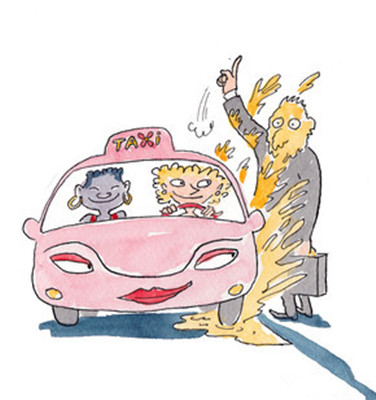Women-only cabs
女士专用出租车
Fare Ladies
女驾驶员
A new car service offers lifts for women, from women
新的打的服务—女司机载女乘客
WOMEN have been driving yellow cabs in New York since the 1940s, but 99% of drivers are male. Even among drivers of cars booked by phone or online, only 4% are women. That may change with the launch of SheTaxis, an app that lets female passengers insist on female drivers, and vice versa.
自20世纪40年代纽约就已经出现了开黄色出租车的女司机,但是99%的都是男司机。就算是通过电话或网络订车,也仅有4%的女司机。不过这一情况可能因为粉色出租车这个应用软件的出现而改变。该软件能够满足女乘客订女司机驾驶的出租车,同样也适用于男乘客。

It will be available in New York City, Westchester and Long Island, and the firm plans to expand to other cities. Stella Mateo, the founder, is betting that quite a few women are nervous and weary of getting into cars driven by men. The service may also appeal to those whose religious beliefs forbid them to travel with unrelated men. Each driver wears a pink pashmina. Men who ask for a ride will be directed to another car service.
在纽约城、维斯切斯特以及长岛人们就可以享受该服务,当地人称之为“粉色座驾”,该公司计划将该服务推广至其他城市。该公司的创始人Stella Mateo打赌称有些女乘客上了男司机开的出租车会很紧张很害怕。这项服务也会受到那些有宗教信仰人士的欢迎,因为她们的宗教信念禁止她们与不相关的男性同行。粉色座驾的司机都会穿戴一件粉红色的羊绒衫,若有男士坐车将会指引坐另外的出租车。
Similar services thrive in India, South Africa and several Middle Eastern cities. Some Brazilian and Mexican cities offer women-only public-transport programmes known as “pink transport”. Japan has had women-only railway carriages on and off since 1912. Known as hana densha (flower trains), they offer a haven from the gropers who make rush hour in Tokyo so disagreeable. Women-only hotel floors are popular, too.
与此类似的服务在印度、南非和众多中东城市发展迅速。巴西和墨西哥的一些城市专门为女性 提供被称为“粉色运输”的公共交通项目。日本自1912年开始就不断地推出专为女性设置的客运列车。著名的花朵火车为那些在东京早晚高峰时段艰难摸索进站 的女性提供了避难所,乘地铁不再那么令人难以忍受。宾馆提供的女士专用楼层也大受欢迎。
But SheTaxis faces two speed bumps. One is practical. Demand has been so great that the firm has had to decelerate its launch until it can recruit 500 drivers. The other obstacle is legal. By employing only female drivers, SheTaxis is obviously discriminating against men. Since anti-discrimination law is not always applied with common sense, that may be illegal. And there is no shortage of potential litigants. Yellow cabbies are furious at the growth of online taxi firms such as Uber. “It's not hard to imagine a guy...filing suit,” says Sylvia Law of New York University Law School. SheTaxi's defence would probably be that its drivers are all independent contractors.”
但是粉色出租车面临两大障碍。一个困难来自实际运营。市场需求过大以至于公司不得不减缓其上市脚步直到招满500名女司机。另一大困难来自法律层面。若仅雇佣女性司机,粉色出租车很明显对男司机有性别歧视。因为反歧视法不会考虑常识,这会导致粉色出租车非法。这样的话潜在诉讼当事人会牵涉到很多人。计程车司机对像尤伯这样的网上出租车公司心怀愤懑。来自纽约大学法学院的西尔维娅·劳称“不难想象男士会提起诉讼”。粉色出租车的辩护将很可能会称它的司机都是独立的承包商。
Because the firm caters only to women, it is discriminating against male customers, too. Is that legal? Angela Cornell of Cornell Law School thinks there could be a loophole. New York's Human Rights Commission could make an exemption on the ground that SheTaxi offers a service that is in the public interest: women feel safer not getting into cars with strange men. Women-only colleges are allowed, so why not women-only cabs? The snag is that some men may also feel safer getting into cabs with female drivers. A study in 2010 found that 80% of crashes in New York City that kill or seriously injure pedestrians involve male drivers. Women drivers are simply better.
由于该公司仅向女性提供服务,它就是歧视男乘客。这合法吗?康奈尔法学院的安吉拉·康奈尔认为这里存在漏洞。纽约人权委员会可以以粉色出租车提供的服务符合公众的利益而豁免其侵权。因为它是基于女乘客坐进女司机驾驶的出租车会感到更安全这一立场而提供服务的。女子大学被允许存在,那为什么粉色出租车就不行呢?障碍是有些男性也认为乘坐女司机开的出租车更有安全感。2010年的一项研究显示,纽约城造成行人死亡或受重伤的交通事故中80%的肇事司机是男性。女性驾驶员相对来说要好得多。












